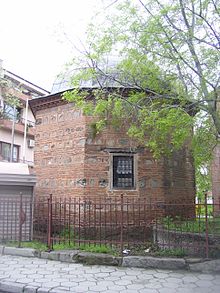Hadım Şehabeddin
Hadim Şehabeddin | |
|---|---|
| Nickname(s) | Kula Şahin |
| Died | 1453 Bursa, Ottoman Empire (modern-day Turkey) |
| Buried | |
| Rank |
|
| Battles/wars |
|
Hadım Şehabeddin Paşa (Old Turkish: Şihābüddīn; fl. 1436–53), also called Kula Şahin Paşa, was an
Name and early life
Şehabeddin is commonly identified also as Kula Şahin Paşa.
Military career

He advanced in the court hierarchy and became
Against the orders of Şehabeddin the Ottoman forces captured and garrisoned medieval fortress
On 2 or 6
Legacy
Şehabeddin built a mosque in 1436 in
References
- ^ a b Dijkema 1977, p. 25.
- ^ a b c Rogers, DeVries & France 2012, p. 154.
- ^ a b c Jefferson 2012, p. 13.
- ISBN 9789545230721.
Sehabeddin Pasa, devsirme conscript.
- ^ Jefferson 2012, p. 84.
- ISBN 9789757480945.
- ^ a b c Jefferson 2012, p. 85.
- Ćirković, Sima M. (1982). Istorija srpskog naroda: knj. Od najstarijih vremena do Maričke bitke (1371). Srpska književna zadruga. p. 254.
- ISBN 9788671790215.
Послове је непосредно надзирао ру- мелијски беглербег Шехабедин.
- ^ Setton, Hazard & Zacour 1990, p. 267.
- ^ Imber 1990, p. 119.
- ^ Vojni muzej JNA (1957). Vesnik. Vojni muzej JNA. p. 223.
Posle toga Novo Brdo su opljaökali i popalild.
- ^ Godišnjak Društva istoričara Bosne i Hercegovine. Društvo istoričara Bosne i Hercegovine. 1986. p. 86.
Kada je saslušao Primovićevo izlaganje u Dobrijevu kod Vučitrna, Sehabedin je blagonaklono savjetovao da Dubrovčani, ako već neće da plaćaju harač, trebaju naći neki drugi način da »ukažu čast sultanu«. Zato je Malo vijeće naredilo ...
- ^ Giurescu, Constantin C.; Matei, Horia C. (1976). Histoire Chronologique de la Roumanie. Editura științifică și enciclopedică. p. 88.
- ^ Jefferson 2012, p. 280.
- ^ Sahabettin Paşa (Hadım)
- ISBN 978-1-84564-506-9.
- ^ Gradu, Zbornik za Istocnjacku Istorisku i Knjizevnu (1940). Serija 1. p. 1119.
Sources
- Dijkema, F. Th. (1977). The Ottoman Historical Monumental Inscriptions in Edirne. BRILL. pp. 24–25. ISBN 90-04-05062-0.
- ISBN 978-90-04-21904-5.
- Imber, Colin (1990). The Ottoman empire: 1300-1481. Isis. ISBN 978-975-428-015-9.
- ISBN 978-0-299-10744-4.
- ISBN 978-1-84383-747-3.
